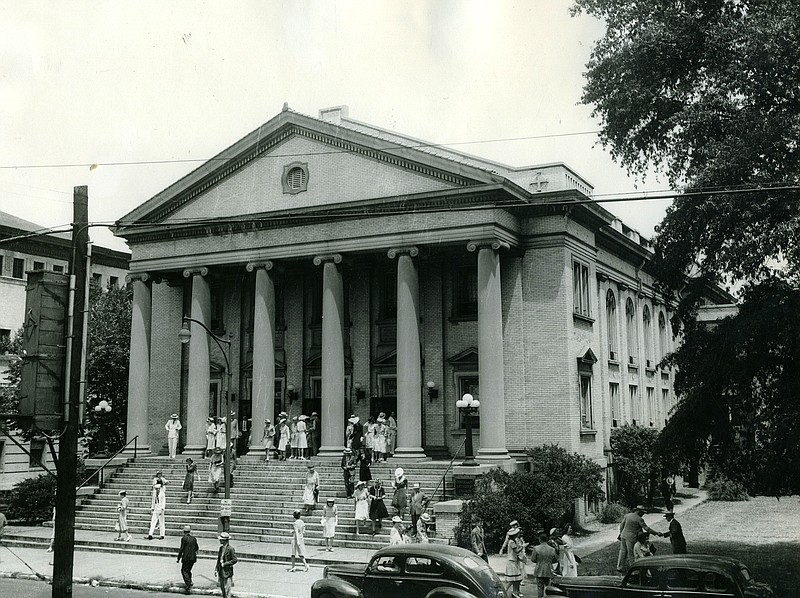Next week:
The origins of First Methodist Church
When the oldest existing Methodist church in Chattanooga was established in 1839, traveling Methodist pastors and Methodist missionaries to the American Indians had been in the area for the better part of two decades.
By the time the Tennessee legislature established the city of Chattanooga later that same year, what is today First-Centenary United Methodist Church had been in the Lord's business for most of a year.
The fledgling congregation first met in a log building between Lookout and High streets near Fifth Street. For a time, the Methodists apparently shared space with the Presbyterians, who'd been there slightly ahead of them but soon moved to their own place at Market and Seventh streets. That allowed the Methodists to claim the land on which the log building stood, and they were granted a deed to it.
Thomas K. Munsey was appointed the first full-time preacher of the Chattanooga Circuit, which included the young congregation, in 1843. Paid $100 a year, he was described in The Southern Review as "one of the most talented, acceptable and useful members of the Holston [Methodist] Conference."
The congregation quickly outgrew the log building and raised $3,500 in the late 1840s for a new one on the site of what is now Wiley Memorial United Methodist Church on Lookout Street, according to "First-Centenary United Methodist Church: A Sesquicentennial History" by Dr. Steve Byrum. The framing was done near Soddy, and the building was floated down the Tennessee River on a raft. Because of the design of the church's distinctive belfry, it became known as the "Pepperbox Church."
David Sullins, who already had achieved a positive reputation in the regional now-Methodist Episcopal Church, South, was appointed to the church in 1857 and later told of his time there in the memoir "Recollections of an Old Man 70 Years in Dixie."
"I do not believe that the question of our support was discussed or mentioned," he wrote. "We had no assessment plan in those days. The old Methodist rule was about this: The people needed a preacher; the church sent them one; they were expected to take care of him, and he was expected to take what the people furnished him. If this fell short of meeting his needs, he was to look for the deficit when he got to heaven; it was never made up here."
During the Civil War, the "Pepperbox Church" was seized by Union troops and used as a hospital. At war's end, it was all but destroyed, and the remaining members used the basement of First Presbyterian Church for services.
The congregation had a difficult time regrouping after the war but eventually built a $12,000 church on a lot at Market and Eighth streets, where the Loveman's Building stands today.
In town for the denomination's regional annual meeting in 1883, Dr. G.C. Rankin described the structure as a "dingy old brick structure, out of date and unattractive." Rankin was appointed to the church a year later, and in time and with the help of a 10-day revival that brought 150 new members, set out to put the congregation into an impressive structure that would rival the stone church being erected by First Methodist of the Methodist Episcopal Church (North).
That $23,875 building at the corner of then Gilmer and A streets (now Eighth and Lindsay) was finished in 1885, the same year as the stone church, and the congregation was named Centenary Methodist in honor of the first century of American Methodism.
The two branches of Methodism would not unite until 1939, and the two original Chattanooga Methodist churches would not merge until 1967. In the meantime, the two churches continued their separate ways, not as bitter rivals but as spirited competitors.
The final piece of the puzzle that set the stage for the merger more than 40 years later was Centenary's next - and final - building on the northeast corner of McCallie Avenue and Lindsay Street. The property was purchased for $25,000 in the first decade of the new century from Dr. Thomas Hooke McCallie Jr., whose father lived there while he was pastor at First Presbyterian Church during the Civil War. But the $275,000 Greek classical-style building that was raised there would not be completed until 1922.
The ultimate merger of the block-apart congregations, engineered in the mid-1960s by new Centenary pastor Dr. Ralph Mohney, combined the cash-rich, declining-membership First Methodist with membership-heavy, land-rich Centenary Methodist. Its present building on McCallie Avenue, which spans the block from Houston and Lindsay, was dedicated in 1973.
Contact Clint Cooper at 423-757-6497 or ccooper@timesfreepress.com.
